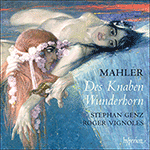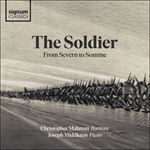In concert, the
Wunderhorn songs are often performed by two singers, male and female, and the collection includes a number of dialogues, of which the most famous,
Wo die schönen Trompeten blasen, is perhaps the emotional highpoint of the whole set. It has a direct ancestor in
Kriegers Ahnung, one of the most compelling songs of Schubert’s
Schwanengesang. Offstage military fanfares and drum beats set the scene, in which a girl is visited by her lover, or by his spirit, on the eve of battle. Whether he is already dead, or has a premonition of death next day, is not absolutely clear, but in either case the rapt tenderness of the encounter, and its foreboding, is unmistakeable, contrasting the tight-laced 2/4 of military duty with the lilting, dreamlike 3/4 of the lovers’ embrace.
from notes by Roger Vignoles © 2008
En concert, les lieder du
Wunderhorn sont souvent chantés par un homme et une femme, et le recueil contient plusieurs dialogues, le plus célèbre,
Wo die schönen Trompeten blasen, marquant peut-être l’apogée émotionnel du corpus. Son ancêtre direct,
Kriegers Ahnung, compte parmi les lieder les plus envoûtants du
Schwanengesang schubertien. En coulisses, fanfares militaires et battements de tambour plantent le décor: à la veille d’une bataille, une jeune fille est visitée par son amant, ou par l’esprit de celui-ci. On ne sait au juste s’il est déjà mort ou s’il pressent la mort qui le frappera le lendemain; toujours est-il que la tendresse ravie de la rencontre, son caractère prémonitoire aussi, sont indéniables, qu’illustre le contraste entre le 2/4 bien serré du devoir militaire et le 3/4 souple, langoureux, de l’étreinte des amants.
extrait des notes rédigées par Roger Vignoles © 2008
Français: Hypérion
Im Konzert werden die
Wunderhorn-Lieder oft von zwei Sängern—einem Mann und einer Frau—aufgeführt, und die Sammlung enthält einige Dialoge, von denen
Wo die schönen Trompeten blasen nicht nur der berühmteste ist, sondern womöglich auch der emotionale Höhepunkt der ganzen Sammlung. Er hat einen direkten Vorgänger in
Kriegers Ahnung, einem der fesselndsten Lieder aus Schuberts
Schwanengesang. Entfernte Militärfanfaren und Trommelschläge setzen die Szene, in der ein Mädchen am Vorabend einer Schlacht von ihrem Geliebten—oder seinem Gespenst—besucht wird. Ob er schon tot ist oder eine Todesahnung für den nächsten Tag hat, ist nicht genau klar, aber wie auch immer—die verzückte Zärtlichkeit des Treffens und die unheilschwangere Atmosphäre sind im Kontrast zwischen dem militärisch strengen 2/4-Takt und dem träumerischen 3/4 in der Umarmung der Liebenden unverkennbar.
aus dem Begleittext von Roger Vignoles © 2008
Deutsch: Renate Wendel


 Mahler: Des Knaben Wunderhorn
Mahler: Des Knaben Wunderhorn The Soldier
The Soldier
